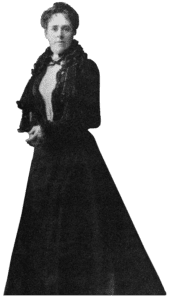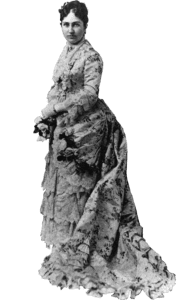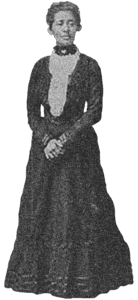Over 125 Years Strong
Alice McLellan Birney and Phoebe Apperson Hearst founded the organization when women did not have the right to vote and social activism was not popular. However, they believed mothers would support their mission to eliminate threats that endangered children, and in early 1897, they started a nationwide campaign.
On Feb. 17, 1897 more than 2,000 people—mostly mothers, but also fathers, teachers, laborers and legislators—attended the first convocation of the National Congress of Mothers in Washington, D.C. Twenty years later, 37 chartered state congresses existed.
In 1970, the National Congress of Parents and Teachers (National PTA) and the National Congress of Colored Parents and Teachers (NCCPT)—founded by Selena Sloan Butler in Atlanta, Ga.—merged to serve all children.
Meet the Founders
Alice McLellan Birney
Alice McLellan Birney, cofounder of what became the Parent-Teacher Association (PTA), always had a strong desire to succeed. She was only 15 when she completed high school and began attending Mount Holyoke. After attending Mount Holyoke, Birney studied medicine before pursuing a successful advertising career.
 Birney cared deeply about children’s welfare and education, writing, “In the child and in our treatment of him rests the solution of the problems which confront the state and society today.” Aiming to create a better world for children and youth by educating mothers on raising and educating children and on child welfare, Birney came up with the idea for the National Congress of Mothers. She and Phoebe Apperson Hearst rallied more than 2,000 people for a “Mothers’ Congress” held in Washington, D.C. in 1897. From it emerged the National Congress of Mothers, which Birney led as president until 1902.
Birney cared deeply about children’s welfare and education, writing, “In the child and in our treatment of him rests the solution of the problems which confront the state and society today.” Aiming to create a better world for children and youth by educating mothers on raising and educating children and on child welfare, Birney came up with the idea for the National Congress of Mothers. She and Phoebe Apperson Hearst rallied more than 2,000 people for a “Mothers’ Congress” held in Washington, D.C. in 1897. From it emerged the National Congress of Mothers, which Birney led as president until 1902.
The National Congress of Mothers, which eventually became the PTA, worked for child labor laws, hot lunch programs, mandatory immunization, a public health service, and kindergarten classes. The group was open to members regardless of race, religion, or social status, and in two years, membership had grown to 50,000. Today the PTA serves more than seven million members.
After resigning as president because of illness, Birney stayed involved in the congress until her death in 1907. Her numerous articles about raising children were published in the 1905 book Childhood.
Phoebe Apperson Hearst
Phoebe Apperson Hearst was born 1842 in Franklin County, Missouri. Before marrying 41 year old George Hearst at the age of 19, Miss Apperson worked as a teacher in area schools.
Soon after their marriage, the couple moved to San Francisco where Phoebe gave birth to their only child, William Randolph in 1863. In 1873, Phoebe took young William on a grand tour of Europe where the two spent more than a year visiting castles, museums and various cultural centers. This trip would prove to be a pivotal inspiration for William’s later endeavor constructing Hearst Castle.
 When George Hearst was elected to the United States Senate in 1887, the couple relocated to Washington D.C. where Phoebe entertained many guests and statesman. Four years later, Phoebe became the sole heir to her husband’s valuable estate upon his death in 1891.
When George Hearst was elected to the United States Senate in 1887, the couple relocated to Washington D.C. where Phoebe entertained many guests and statesman. Four years later, Phoebe became the sole heir to her husband’s valuable estate upon his death in 1891.
After George’s death, Phoebe again returned to California and renewed construction on a palatial residence in Pleasanton, California that had been started by her son a few years earlier. For the project, Mrs. Hearst commissioned Julia Morgan as architect. She would later become the architect behind Hearst Castle.
Throughout her life, Phoebe was dedicated to education and, when her financial status allowed her to, she became a generous philanthropist of various educational endeavors. As early as 1891, she made a large gift to the University of California, Berkeley in order to endow several scholarships for women students. She also funded an international architectural competition for a master plan for the University of California, Berkeley, endowed a scholarship program for students at the University and presented the campus with the gift of the Hearst Memorial Mining Building and Hearst Hall.
Later, she financed a school for the training of kindergarten teachers and founded the first free kindergarten in the United States in 1887. She eventually opened up six more of these free schools supported by her time and money. In 1897, she founded the National Congress of Mothers, a forerunner of the National Council of Parents and Teachers, better known today as the PTA.
Phoebe Apperson Hearst died in 1919, a victim of the worldwide influenza epidemic of 1918-1919.
Selena Sloan Butler
Selena Sloan Butler organized the first National Congress of Colored Parents and Teachers (NCCPT) and cofounded the National Congress of Parents and Teachers, which is now a part of the National Parent Teacher Association (PTA). She centered her life’s work on improving the educational environments and upholding the rights of all children, regardless of their race or situation.
 Butler was born in Thomasville to William Sloan and Winnie Williams on January 4, probably in 1872. Her father was white, and her mother was of mixed descent, half Indian and half African American. She started life with her mother and sister but without her father’s presence, although she did receive his monetary support. She attended a missionary-operated elementary school in Thomas County and studied at Spelman Seminary (later Spelman College). At the age of sixteen Butler graduated from Spelman and began a teaching career in Atlanta. She married Henry Rutherford Butler, a prominent African American doctor in Atlanta who had studied medicine at Harvard University in Cambridge, Massachusetts. Butler began to harness her energies toward protecting the rights of children after her son, Henry Jr., was old enough to attend school.
Butler was born in Thomasville to William Sloan and Winnie Williams on January 4, probably in 1872. Her father was white, and her mother was of mixed descent, half Indian and half African American. She started life with her mother and sister but without her father’s presence, although she did receive his monetary support. She attended a missionary-operated elementary school in Thomas County and studied at Spelman Seminary (later Spelman College). At the age of sixteen Butler graduated from Spelman and began a teaching career in Atlanta. She married Henry Rutherford Butler, a prominent African American doctor in Atlanta who had studied medicine at Harvard University in Cambridge, Massachusetts. Butler began to harness her energies toward protecting the rights of children after her son, Henry Jr., was old enough to attend school.
Butler was active in her community not only as a teacher of English and elocution but also as an organizer. She cofounded the Spelman College Alumnae Association, organized the Phyllis Wheatley Branch of the Atlanta YWCA, and was the first president of the Georgia Federation of Colored Women’s Clubs. In 1929-30 she served on the Committee on the Education and Training of the Infant and Preschool Child for U.S. president Herbert Hoover’s White House Conference on Child Health and Protection.
The first chapter of the NCCPT was founded at Yonge Street Elementary School in Atlanta in 1911, and by 1919 many other chapters had been formed across the state. At that point the local chapters banded together and became the Georgia Congress of Colored Parents and Teachers. It closely followed the model set up by Alice Birney and Phoebe Hearst, who founded the National Congress of Mothers. The NCCPT and the Congress of Mothers worked closely with each other to improve the conditions in schools for all children as well as for teachers. The Congress of Mothers merged with the NCCPT in 1970 to form the current National PTA.
After the death of her husband in 1931 Butler lived in England for a short time while working in the Nursery School Association. Later she moved to Arizona and then to Los Angeles, California, to be with her son and his wife. Henry Jr. practiced medicine just as his father had.
Butler died of congestive heart failure on October 7, 1964, and was buried beside her husband in Oakland Cemetery in Atlanta. Her portrait now hangs in the state capitol. In 1995 Butler was inducted into Georgia Women of Achievement.

